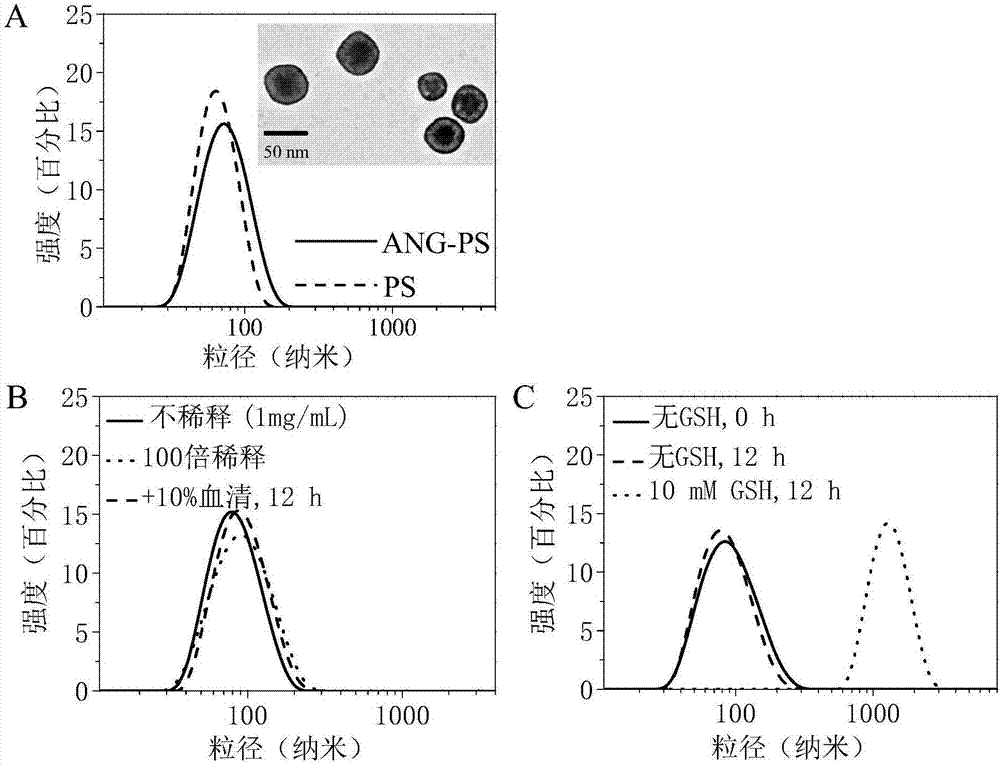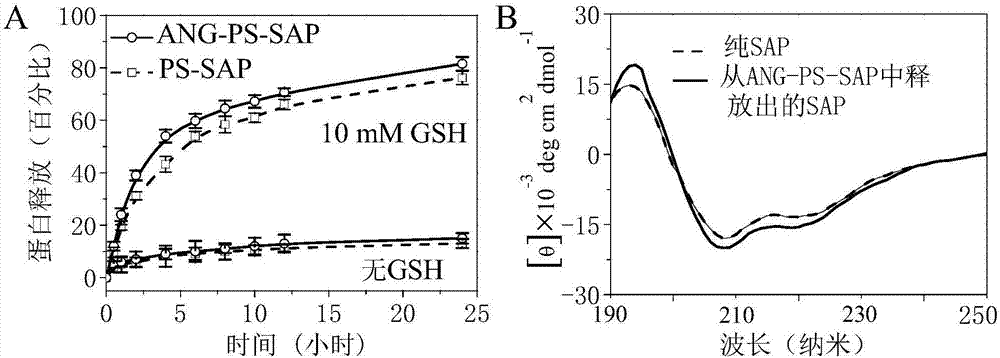Application of targeted reduction response vesicular nanometer medicines in preparation of brain tumor treatment medicines
A technology of nano-drugs and therapeutic drugs, applied in anti-tumor drugs, drug combinations, pharmaceutical formulations, etc., can solve the problems of limited and poor therapeutic effects of brain tumors, and achieve prolonging the circulation time in the body, good biological safety, and preventing drugs. leaked effect
- Summary
- Abstract
- Description
- Claims
- Application Information
AI Technical Summary
Problems solved by technology
Method used
Image
Examples
Embodiment 1
[0055] Example 1 Synthesis of block copolymers PEG5k-P (DTC2k-TMC15k) and PEG5k-P (DTC2k-TMC15k)-bPEI1.8k
[0056] In a nitrogen glove box, weigh MeO-PEG-OH ( M n = 5.0 kg / mol, 0.50 g, 100 μmol), TMC (1.52 g, 14.55 mmol) and DTC (0.23 g, 1.18 mmol) were dissolved in dichloromethane (DCM, 7.0 mL), and the catalyst diphenyl phosphate was added with stirring (DPP, DPP / OH molar ratio is 10 / 1). The airtight reactor was sealed and placed in an oil bath at 40°C under magnetic stirring for 2 days; triethylamine was terminated, precipitated twice in glacial ether, filtered by suction, and dried in vacuum to obtain PEG5k-P (DTC2k-TMC15k).
[0057] PEG5k-P (DTC2k-TMC15k) is prepared by NPC activation of the terminal hydroxyl chloroformate p-nitrophenyl, and then reacting with the primary amine of branched PEI (bPEI). Specifically, PEG5k-P(DTC2k-TMC15k) (0.4 g, hydroxyl 0.017 mmol) and NPC (50 mg, 0.09 mmol) were dissolved in dry DCM and reacted at 0°C for 24 hours, then precipitated ...
Embodiment 2
[0059] Example 2 Synthesis of Targeted Copolymer
[0060] Targeting polymers can be synthesized in various ways, depending on the terminal functionalization groups of PEG. ANG-PEG7.5k-P(DTC2k-TMC15k) was synthesized in two steps. The first step is similar to the synthesis of PEG5k-P (DTC2k-TMC15k) in Example 1, but with Mal-PEG-OH (Mn=7.5 kg / mol) instead of MeO-PEG-OH ( M n =5.0 kg / mol) as the initiator to initiate the ring-opening polymerization of DTC and TMC to obtain Mal-PEG7.5k-P (DTC2k-TMC15k). Then, under nitrogen, the DMSO solution of ANG was added dropwise to the DMSO solution of Mal-PEG7.5k-P (DTC2k-TMC15k) according to the latter molar ratio of 1.2:1, stirred at 37 degrees for 8 hours, and then dialyzed in DMSO for 24 hours. Hours and then dialyzed with secondary water for 12 hours, freeze-dried to obtain ANG-PEG7.5k-P (DTC2k-TMC15k), with a yield of 92%. It can be known by NMR integration that the molecular weight of the polymer is 7.5-(2.0-14.7) kg / mol. The ...
Embodiment 3
[0062] Example 3 Synthesis of Block Polymer PEG5k-P(TMC15k-DTC2k)-Sp
[0063] PEG5k-P(DTC2k-TMC15k)-NPC synthesized by the same method as in Example 1 was dissolved in 3 mL of DCM, then added dropwise to 3 mL of DCM with spermine (26 mg, 0.13 mmol), and reacted at 30°C for 48 hours Afterwards, dialyze (MWCO 7000) in DCM and methanol (volume ratio 1:1) for 48 hours, precipitate with glacial ether twice, filter with suction, and dry in vacuo to obtain PEG5k-P(DTC2k-TMC15k)-Sp. Yield: 94.7%. NMR and TNBSA showed that the grafting rate of Sp was 97%. Table 1 lists the preparation conditions of each polymer and the NMR characterization results of the product, and the targeting molecule ANG can be connected through the linking group.
[0064] Table 1 The preparation conditions of each polymer and the NMR characterization results of the products
[0065]
PUM
| Property | Measurement | Unit |
|---|---|---|
| molecular weight | aaaaa | aaaaa |
| molecular weight | aaaaa | aaaaa |
| degree of grafting | aaaaa | aaaaa |
Abstract
Description
Claims
Application Information
 Login to View More
Login to View More - R&D
- Intellectual Property
- Life Sciences
- Materials
- Tech Scout
- Unparalleled Data Quality
- Higher Quality Content
- 60% Fewer Hallucinations
Browse by: Latest US Patents, China's latest patents, Technical Efficacy Thesaurus, Application Domain, Technology Topic, Popular Technical Reports.
© 2025 PatSnap. All rights reserved.Legal|Privacy policy|Modern Slavery Act Transparency Statement|Sitemap|About US| Contact US: help@patsnap.com



